8.12 Realtime Message Ingestion to Azure Event Hubs with Oracle GoldenGate for Distributed Applications and Analytics
Overview
This Quickstart covers a step-by-step processes showing how to ingest messages to Azure Event Hub in real-time with Oracle GoldenGate for Distributed Applications and Analytics (GG for DAA).
Azure Event Hubs is a cloud native data streaming service that can stream high volumes of messages. Azure Event Hubs provides an Apache Kafka endpoint on an event hub, which enables users to connect to the event hub using the Kafka protocol.GG for DAA connects to Azure Event Hub Apache Kafka Endpoint with Kafka Handler. GG for DAA reads the source operations from the trail file, formats them, maps to Azure Event Hubs and delivers.
- Prerequisites
- Install Dependency Files
- Create a producer.properties for Azure Event Hubs
- Create a Replicat in Oracle GoldenGate for Distirbuted Applications and Analytics
Parent topic: Quickstarts
8.12.1 Prerequisites
To successfully complete this Quickstart, you must have the following:
- An Azure Event Hubs Namespace
- Shared Access Policies for your Azure Event Hubs Namespace
tr), which is
shipped with GG for DAA is used. The sample trail file is located at
GG_HOME/opt/AdapterExamples/trail/ in your GG for DAA
instance.
8.12.2 Install Dependency Files
GG for DAA uses Apache Kafka client libraries for Azure Event Hubs. You can download the SDKs using Dependency Downloader utility shipped with GG for DAA. Dependency downloader is a set of shell scripts that downloads dependency jar files from Maven and other repositories.
- In your GG for DAA VM, go to dependency downloader utility. It is
located at
GG_HOME/opt/DependencyDownloader/and locatekafka.sh. - Run
kafka.shwith the required version. You can check the version and reported vulnerabilities in Maven Central. This document uses 3.7.0 which is the latest version when this quick start is published.Figure 8-83 Run kafka.sh

- A new directory is created in
/u01/app/ogg/opt/DependencyDownloader/dependencies/kafka_3.7.0.
8.12.3 Create a producer.properties for Azure Event Hubs
In GG for DAA instance, create a file called
producer.properties and copy the following
configuration.
bootstrap.servers=<namespace>.servicebus.windows.net:9093 security.protocol=SASL_SSL sasl.mechanism=PLAIN sasl.jaas.config=org.apache.kafka.common.security.plain.PlainLoginModule required username="$ConnectionString" password=" Endpoint=sb://mynamespace.servicebus.windows.net/;SharedAccessKeyName=RootManageSharedAccessKey;SharedAccessKey=XXXXXXXXXXXXXXXX"; value.serializer = org.apache.kafka.common.serialization.ByteArraySerializer key.serializer = org.apache.kafka.common.serialization.ByteArraySerializerFor more information, see Azure Event Hub Shared Access Key.
8.12.4 Create a Replicat in Oracle GoldenGate for Distirbuted Applications and Analytics
To create a replicat in Oracle GoldenGate for Distirbuted Applications and Analytics (GG for DAA):
- In the GG for DAA UI, in the Administration Service tab,
click the + sign to add a replicat.
Figure 8-84 Click + in the Administration Service tab.

- Select the Classic Replicat Replicat Type and click
Next There are two different Replicat types available: Classic and
Coordinated. Classic Replicat is a single threaded process whereas Coordinated
Replicat is a multithreaded one that applies transactions in parallel.
Figure 8-85 Add Replicat
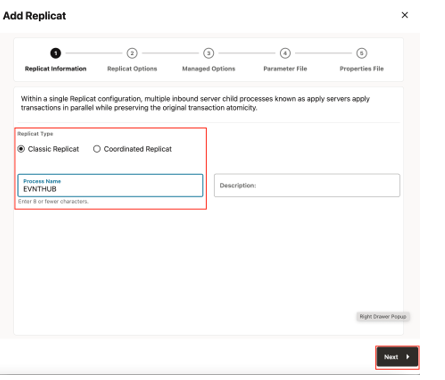
- Enter the basic information, and click Next:
- Replicat Trail : Name of the required trail file (if using sample trail, provide as tr)
- Subdirectory: Enter
GG_HOME/opt/AdapterExamples/trail/if using the sample trail. - Target: Kafka
Figure 8-86 Replicat Options
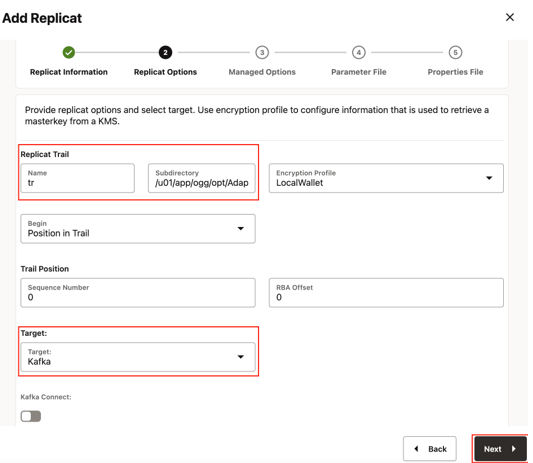
- Leave Managed Options as is and click Next.
Figure 8-87 Managed Options

- Enter Parameter File details and click Next. In the
Parameter File, you can specify source to target mapping or leave it as-is with
a wildcard selection.
Figure 8-88 Parameter File
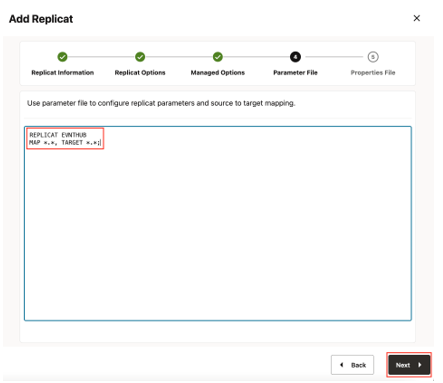
- In the Properties file, update the properties marked as TODO
and click Create and
Run.
#Kafka Handler Template gg.handlerlist=kafkahandler gg.handler.kafkahandler.type=kafka #TODO: Set the name of the Kafka producer properties file. gg.handler.kafkahandler.kafkaProducerConfigFile=/path_to/producer.properties #TODO: Set the template for resolving the topic name. gg.handler.kafkahandler.topicMappingTemplate=<target_event_hub_name> gg.handler.kafkahandler.keyMappingTemplate=${primaryKeys} gg.handler.kafkahandler.mode=op gg.handler.kafkahandler.format=json gg.handler.kafkahandler.format.metaColumnsTemplate=${objectname[table]},${optype[op_type]},${timestamp[op_ts]},${currenttimestamp[current_ts]},${position[pos]} #TODO: Set the location of the Kafka client libraries. gg.classpath=path_to/dependencies/kafka_3.7.0/* jvm.bootoptions=-Xmx512m -Xms32m
GG for DAA supports dynamic topic mapping by template keywords. For example, if you assigntopicMappingTemplateas${tablename}, GG for DAA will create an Event Hub with the source table name, per each source table and will map the events to these topics. Oracle recommends to usekeyMappingTemplate=${primaryKeys}, GG for DAA sends the source operations with the same pk to the same partition. This will guarantee maintaining the order of the source operations while delivering to Azure Event Hubs. - If replicat starts successfully, it will be in running state. You
can go to action/details/statistics to see the replication statistics.
Figure 8-89 Replicat Statistics
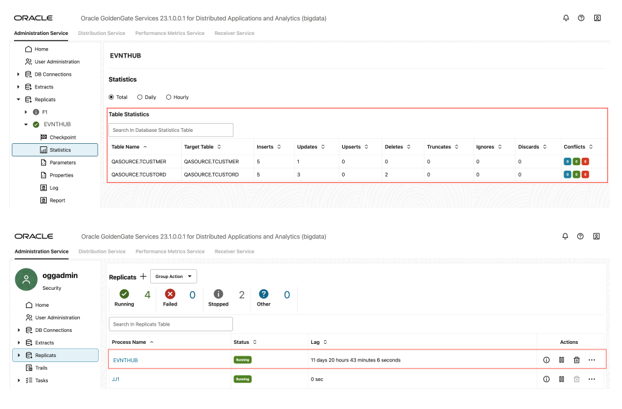
- You can go to Azure Event Hub console and check the statistics.
Figure 8-90 Azure Event Hub console
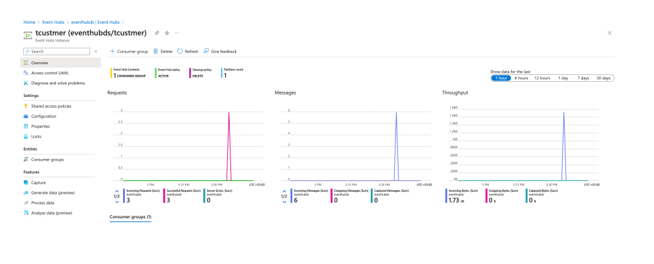
For more details about Azure Event Hub replication, see Apache Kafka.
Note:
- If target kafka topic does not exist, then it is auto created by GG for DAA if the auto topic create is selected in OCI Streaming Kafka connection settings. You can use Template Keywords to dynamically assign topic names.
- See blog for improving the performance of the OCI Streaming replication.